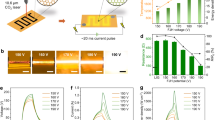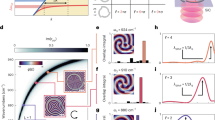Abstract
Under intense laser excitation, thin films and suspensions of graphite and its nanostructure, including carbon black, nanotubes, few-layer graphenes and graphene oxides, exhibit induced transparency due to saturable absorption. This switches to optical limiting only at very high fluences when induced breakdown gives rise to microbubbles and microplasmas that causes nonlinear scattering. Here, we show that dispersed graphenes, in contrast, can exhibit broadband nonlinear optical absorption at fluences well below this damage threshold with a strong matrix effect. We obtained, for nanosecond visible and near-infrared pulses, a new benchmark for optical energy-limiting onset of 10 mJ cm−2 for a linear transmittance of 70%, with excellent output clamping in both heavy-atom solvents and polymer film matrices. Nanosecond pump–probe spectroscopy in chlorobenzene reveals that the nanographene domains switch from the usual broadband photo-induced bleaching to a novel reverse saturable absorption mechanism with increasing excitation densities across this threshold.
This is a preview of subscription content, access via your institution
Access options
Subscribe to this journal
Receive 12 print issues and online access
$209.00 per year
only $17.42 per issue
Buy this article
- Purchase on Springer Link
- Instant access to full article PDF
Prices may be subject to local taxes which are calculated during checkout






Similar content being viewed by others
References
Tutt, L. W. & Boggess, T. F. A review of optical limiting mechanisms and devices using organics, fullerences, semiconductors and other materials. Prog. Quantum Electron. 17, 299–338 (1993).
Sun, Y. P. & Riggs, J. E. Organic and inorganic optical limiting materials: from fullerenes to nanoparticles. Int. Rev. Phys. Chem. 18, 43–90 (1999).
Mansour, K., Soileau, M. J. & Van Stryland, E. W. Nonlinear optical properties of carbon-black suspensions (ink). J. Opt. Soc. Am. B 9, 1100–1109 (1992).
Nashold, K. M. & Walter, D. P. Investigations of optical limiting mechanisms in carbon particle suspensions and fullerene solutions. J. Opt. Soc. Am. B 12, 1228–1237 (1995).
Chen, P. et al. Electronic structure and optical limiting behavior of carbon nanotubes. Phys. Rev. Lett. 82, 2548–2551 (1999).
Vivien, L. et al. Single-wall carbon nanotubes for optical limiting. Chem. Phys. Lett. 307, 317–319 (1999).
Riggs, J. E., Walker, D. B., Carroll, D. L. & Sun, Y. P. Optical limiting properties of suspended and solubilized carbon nanotubes. J. Phys. Chem. B 104, 7071–7076 (2000).
Brandelik, D. et al. Nonlinear optical properties of buckminsterfullerene solutions. Mater. Res. Soc. Symp. Proc. 247, 361–366 (1992).
Tutt, L. W. & Kost, A. Optical limiting performance of C60 and C70 solutions. Nature 356, 225–226 (1992).
Perry, J. W. et al. Organic optical limiter with a strong nonlinear absorptive response. Science 273, 1533–1536 (1996).
de la Torre, G., Vázquez, P., Agulló-López, F. & Torres, T. Role of structural factors in the nonlinear optical properties of phthalocyanines and related compounds. Chem. Rev. 104, 3723–3750 (2004).
Senge, M. O. et al. Nonlinear optical properties of porphyrins. Adv. Mater. 19, 2737–2774 (2007).
Vivien, L. et al. Picosecond and nanosecond polychromatic pump–probe studies of bubble growth in carbon-nanotube suspensions. J. Opt. Soc. Am. B 19, 208–214 (2002).
Wang, J. et al. Broadband nonlinear optical response of graphene dispersions. Adv. Mater. 21, 2430–2435 (2009).
Zhao, B. et al. Nonlinear optical transmission of nanographene and its composites. J. Phys. Chem. C 114, 12517–12523 (2010).
Feng, M., Zhan, H. & Chen, Y. Nonlinear optical and optical limiting properties of graphene families. Appl. Phys. Lett. 96, 033107 (2010).
Wang, S. et al. Band-like transport in surface-functionalised highly solution-processable graphene nanosheets. Adv. Mater. 20, 3440–3446 (2008).
Lerf, A., He, H., Forster, M. & Klinowski, J. Structure of graphite oxide revisited. J. Phys. Chem. B 102, 4477–4482 (1998).
Szabó, T. et al. Evolution of surface functional groups in a series of progressively oxidized graphite oxides. Chem. Mater. 18, 2740–2749 (2006).
Cai, W. W. et al. Synthesis and solid-state NMR structural characterization of C13-labeled graphite oxide. Science 321, 1815–1817 (2008).
Gao, W., Alemany, L. B., Ci, L. & Ajayan, P. M. New insights into the structure and reduction of graphite oxide. Nature Chem. 1, 403–408 (2009).
Chua, L.-L. et al. Deoxidation of graphene oxide nanosheets to extended graphenites by ‘unzipping’ elimination. J. Chem. Phys. 129, 114702 (2008).
Stankovich, S. et al. Graphene-based composite materials. Nature 442, 282–286 (2006).
Schniepp, H. C. et al. Functionalised single graphene sheets derived from splitting graphite oxide. J. Phys. Chem. B 110, 8535–8539 (2006).
Eda, G. & Chhowalla, M. Chemically derived graphene oxide: towards large-area thin-film electronics and optoelectronics. Adv. Mater. 22, 2392–2415 (2010).
Sun, X. et al. Broadband optical limiting with multiwalled carbon nanotubes. Appl. Phys. Lett. 73, 3632–3634 (1998).
Reitze, D. H., Wang, X., Ahn, H. & Downer, M. C. Femtosecond laser melting of graphite. Phys. Rev. B 40, 11986–11989 (1989).
Seibert, K. et al. Femtosecond carrier dynamics in graphite. Phys. Rev. B 42, 2842–2851 (1990).
Breusing, M., Ropers, C. & Elsaesser, T. Ultrafast carrier dynamics in graphite. Phys. Rev. Lett. 102, 086809 (2009).
Bao, Q. et al. Atomic-layer graphene as a saturable absorber for ultrafast pulsed lasers. Adv. Funct. Mater. 19, 3077–3083 (2009).
Kumar, S. et al. Femtosecond carrier dynamics and saturable absorption in graphene suspensions. Appl. Phys. Lett. 95, 191911 (2009).
Turro, N. J. Modern Molecular Photochemistry (University Science Books, 1991).
Zhuo, J. M. et al. Direct evidence for delocalisation of charge carriers at the Fermi level in a doped conducting polymer. Phys. Rev. Lett. 100, 186601 (2008).
Zhou, M. et al. The role of delta-doped interfaces for ohmic contacts to organic semiconductors. Phys. Rev. Lett. 103, 036601 (2009).
Clark, J., Silva, C., Friend, R. H. & Spano, F. C. Role of intermolecular coupling in the photophysics of disordered organic semiconductors: aggregate emission in regioregular polythiophene. Phys. Rev. Lett. 98, 206406 (2007).
Acknowledgements
L.L.C. acknowledges the Ministry of Education Academic Research Fund for funding. P.K.H.H. acknowledges the Defence Science and Technology Agency for Temasek Young Investigator's award. R.H.F. acknowledges the Tan Chin Tuan Foundation for National University of Singapore Centennial Professorship. J.C. acknowledges the Royal Society for a Dorothy Hodgkin fellowship.
Author information
Authors and Affiliations
Contributions
G.K.L. and L.L.C conceived the idea, performed the experiment and analysed the data. J.C. performed the experiments and analysed the data. R.H.F and P.K.H.H. analysed the data. Z.L.C. and R.G.S.G. synthesized and characterized the graphene materials. W.H.N and H.W.T. contributed to Z-scan measurement setup. G.K.L, J.C., R.H.F., P.K.H.H. and L.L.C. contributed to writing the paper.
Corresponding authors
Ethics declarations
Competing interests
The authors declare no competing financial interests.
Supplementary information
Supplementary information
Supplementary information (PDF 1665 kb)
Rights and permissions
About this article
Cite this article
Lim, GK., Chen, ZL., Clark, J. et al. Giant broadband nonlinear optical absorption response in dispersed graphene single sheets. Nature Photon 5, 554–560 (2011). https://doi.org/10.1038/nphoton.2011.177
Received:
Accepted:
Published:
Issue Date:
DOI: https://doi.org/10.1038/nphoton.2011.177
This article is cited by
-
Tuning coherent phonon dynamics in two-dimensional phenylethylammonium lead bromide perovskites
Nano Research (2023)
-
Dramatic femtosecond nonlinear absorption at a strongly coupled porphyrin-graphene nanoconjugate
Nano Research (2023)
-
Synthesis of a novel organic chromophore (HCzN) for photophysical and nonlinear optical response showing its potential in photonic applications
Optical and Quantum Electronics (2023)
-
The influence of laser-induced alignment on Z-scan properties of 2D carbon nanomaterials suspension dependent on polarization
Scientific Reports (2022)
-
LOEN: Lensless opto-electronic neural network empowered machine vision
Light: Science & Applications (2022)



